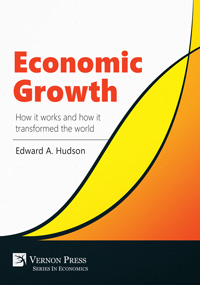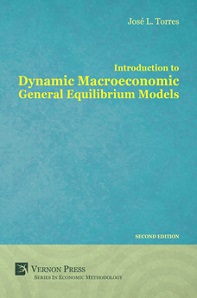Introduction to Dynamic Macroeconomic General Equilibrium Models
by José Luis Torres Chacon (Universidad de Málaga, Spain)
Purchase this book
(click here to change currency)
"An impressive achievement. A book that all beginners to the topic should read, use and consult."
Prof. Fabio Canova
Pierre Werner Chair of Monetary Union, European University Institute
This book offers an introductory step-by-step course in Dynamic Stochastic General Equilibrium (DSGE) modelling. Modern macroeconomic analysis is increasingly concerned with the construction, calibration and/or estimation and simulation of DSGE models. The book is intended for graduate students as an introductory course to DSGE modelling and for those economists who would like a hands-on approach to learning the basics of modern dynamic macroeconomic modelling. The book starts with the simplest canonical neoclassical DSGE model and then gradually extends the basic framework incorporating a variety of additional features, such as consumption habit formation, investment adjustment cost, investment-specific technological change, taxes, public capital, household production, non-ricardian agents, monopolistic competition, etc. The book includes Dynare codes for the models developed that can be downloaded from the book’s homepage.
The second edition is identical to the first with the exception of a revised appendix to Chapter 2. The revised appendix can be downloaded free of charge in the accompanying downloads section.
PART I Introduction to DSGE modelling
Chapter 1
Introduction
Macroeconomic DSGE Modelling
DSGE software
Book organization
Bibliography
Chapter 2 The Canonical Dynamic Macroeconomic General Equilibrium model
Introduction
Households
Alternative functional forms for the utility function
The firms
Alternative functional forms of the production function
Model Equilibrium
Model Equilibrium(Competitive Equilibrium)
Model Equilibrium(Central Planning)
The Steady State
The Dynamic Stochastic General Equilibrium model
Equations of the model and calibration
Equilibrium equations
Calibration
Aggregate productivity shock
Conclusions
Bibliography
PART II Deviations from the Permanent Income-Life Cycle hypothesis
Chapter 3 Habit Formation
Introduction
Habit formation
The model
Households
The firms
Equilibrium
Equations of the model and calibration
Total Factor Productivity shock
Conclusions
Bibliography
Chapter 4 Non-Ricardian Agents
Introduction
Ricardian and Non-Ricardian Agents
The model
Ricardian Households
Non-Ricardian Households
Aggregation
The firms
Equilibrium of the model
Equations of the model and calibration
Total Factor Productivity shock
Conclusions
Bibliography
PART III Investment and Capital Accumulation
Chapter 5 Investment adjustment costs
Introduction
Investment adjustment costs
The model
Households
The firms
Equilibrium of the model
Equations of the model and calibration
Total Factor Productivity Shock
Conclusions
Bibliography
Chapter 6 Investment-Specific Technological Change
Introduction
Investment-specific technological change
The model
Households
The firms
Equilibrium of the model
The balanced growth path
Equations of the model and calibration
Investment-Specific Technological shock
Conclusions
Bibliography
PART IV The government
Chapter 7 Taxes
Introduction
Taxes
The model
Households
The firms
The government
Equilibrium of the model
Equations of the model and calibration
The Laffer curve
Taxes changes
Total Factor Productivity shock
Conclusions
Bibliography
Chapter 8 Public Spending
Introduction
Public spending
The model
Households
The firms
The government
Equilibrium of the model
An alternative functional form for aggregate consumption
Equations of the model and calibration
Public consumption change
Conclusions
Bibliography
Chapter 9 Public Capital
Introduction
Public capital
The model
Households
Firms
The government
Equilibrium of the model
Equations of the model and calibration
Public investment shock
Conclusions
Bibliography
PART V Time Decisions
Chapter 10 Human Capital
Introduction
Human Capital
The Model
Households
Firms
Equations of the model and calibration
Total Factor Productivity shock
Conclusions
Bibliography
Chapter 11 Home Production
Introduction
Home Production
The model
Households
The goods market sector
Home production sector
Household’s maximization problem
Equilibrium of the model
Equations of the model and calibration
Total Factor Productivity shock
Conclusions
Bibliography
PART VI Imperfect competition
Chapter 12 Monopolistic Competition
Introduction
Monopolistic Competition
The model
Households
The firms
Equilibrium of the model
Equations of the model and calibration
Total Factor Productivity Shock
Conclusions
Bibliography
Index
José L. Torres is Associate Professor of Economics, Head of the Department of Economics, Faculty of Economics, University of Málaga (Spain). His current research areas include: Technological Change, Economic Growth, Dynamic General Equilibrium modelling. He has published several books and a large number of papers in journals as Information Economics and Policy, Public Choice, Macroeconomic Dynamics, Journal of Macroeconomics, Eastern European Economics, Empirical Economics, Economic Modelling, Open Economies Review, Economic Letters, Journal of International Financial Markets, Institutions and Money, SERIES, and Economic Issues.
Subjects
Economics
Statistics and Quantitative Methods
Series
Series in Economic Methodology
Related services
Find in a library near you Download print-friendly flyer Download sample chapter Download HQ cover Find in Bookshop.org Find this title in AmazonDownload accompanying files You can download software code for the models described in the book, using Dynare. Dynare is a freely-available, open source software platform for economic modeling, and can be downloaded from: http://www.dynare.org/ The following files are contained in the ZIP file available below (the number refers to the corresponding book chapter): model2.mod: Canonical Dynamic General Equilibrium Models. model3.mod: Habit persistence. model4.mod: Ricardian and Non-Ricardian agents. model5.mod: Investment adjustment costs. model6.mod: Investment-specific technological change. model7a.mod: Taxes: Non-announced permanent change in the consumption tax rate model7b.mod: Taxes: Non-announced transitory change in the consumption tax rate model7c.mod: Taxes: Announced transitory change in the consumption tax rate model8a.mod: Public spending: Permanent change in public consumption model8b.mod: Public spending: Stochastic change in public consumption model9.mod: Public capital. model10.mod: Human capital. model11.mod: Home production. model12.mod: Monopolistic competition. A revised appendix to Chapter 2 (as appears in the second edition) is also included.
See also
Bibliographic Information
Book Title
Introduction to Dynamic Macroeconomic General Equilibrium Models
ISBN
978-1-62273-030-8
Edition
2nd
Number of pages
282
Physical size
236mm x 160mm

![Introduction to Dynamic Macroeconomic General Equilibrium Models [Second Edition, Hardback]](/file/737/51be212f1a405cc9c2fcab4a020e0fc0/1440332689.jpg)




